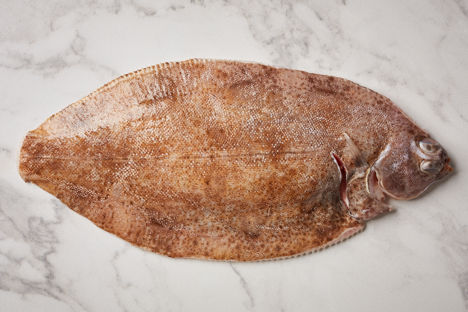Despite the name, lemon sole doesn't actually taste anything like lemon, but rather has a sweet, delicate flavour. The name instead, refers to the shape of the fish, which is rather lemon-like. The fish isn't actually a sole either, but a flounder. Though not the same family as the Dover sole, the two are quite interchangeable. The average lemon sole is around 30cm in size (but they can reach up to 65cm) and has a white belly and mottled brown skin.
What to look for when buying lemon sole
Lemon sole is in season from January to May, and is a very plentiful fish– particularly on the Cornish coast. This means it’s very well-priced, and a cheaper alternative to Dover sole. Although rated as sustainable by the MCS, make sure you always buy it from a trusted supplier.
Be sure to pick fish larger than 25cm to avoid ones that are immature and, as with buying any fish, check for clear, non-cloudy eyes, firm flesh and a clean smell of the sea. The fins and tail should not be damaged.
Portions are typically one fish per person, often served whole, which makes for a nice, easy preparation for the trepidatious fish cook. However, fillets are also available to buy ready-prepped. Sole bones make great fish stock, so ask to keep them if purchasing from a fish-mongers.
Due to its delicate flavour and thin fillets, care must be taken when cooking lemon sole. Cooking the fish whole is the guaranteed way to success here; it's quick, minimal fuss, and the smaller fish are a perfect portion for one. You can serve up on show-stopping platters, or it's easy enough to fillet once cooked– the tough brown skin will peel away easily, then the flesh should come away from the bones perfectly.
If you're cooking fillets, you can dredge them in flour first, which will help give them a crisp and golden finish without having to cook them for too long (which can result in them drying out.) Rolling the fillets up into little coils and steaming or baking them is also a good way of preventing the fish from drying out.
Take a look at our quick and easy methods for cooking whole or pan-fried below.
How to cook whole lemon sole in the oven
Metric
Imperial
- 1 whole lemon sole, approx. 1kg
- 2 knobs of butter
- salt
- freshly ground black pepper
- 1 lemon
- 1 small bunch of flat leaf parsley
Preheat the oven to 200ºC/gas mark 6 and line an oven tray with greaseproof paper
Use a knife to cut off the head at the gills, and using a pair of kitchen scissors, snip away the fins, frills and tail (you could also ask your fishmonger to do this for you). Be sure to rinse the head and trimmings in cold water and save for stock!
Place the fish onto the tray, then gently slash the flesh about 5mm deep, diagonally over the fish
Season with salt and pepper, then rub with the butter, grate lemon zest over the top and squeeze over some juice
Chop the parsley in half, roughly separating the stalks and leaves. Place the stalks on top of the fish and place in the oven to bake for 8–10 minutes or until the flesh easily comes away from the bone at the thickest part of the fillet (by the head)
As the fish cooks, finely chop the parsley leaves. Once the fish is ready, remove the stalks and discard, transfer to a serving dish, then sprinkle with chopped parsley leaves
How to pan-fry lemon sole fillets
Metric
Imperial
- Doves Farm Organic Plain White Flour
- 2 lemon sole fillets, skinned and pin-boned
- 2 knobs of butter
- 1/2 lemon
- salt
- cracked black pepper
Lightly dust the fish in flour, tapping the sides to knock off any excess flour
Place a large non-stick pan over a medium heat and add the butter
Once melted, add the fish fillets and cook for a minute on each side, flipping the fillets over very carefully with a cranked spatula
Finish with a generous squeeze of lemon, salt and pepper just before taking off the heat
Rest for 30 seconds in the pan before serving up hot
Steamed sole
Steaming is an excellent way to cook lemon sole if you want to really celebrate its delicate, pure flavour. The thin fillets don’t take long to cook so it can be a very speedy way to make dinner. The French classic Sole Veronique involves gently steaming the fish in vermouth, before serving it up in a gentle cream sauce. Paul Foster gently pan-steams sole fillets with butter and serves it with asparagus and peas, a real celebration of Spring.
Whole sole
Fried fish
If filleted, small flat fish like sole only needs a couple of minutes cooking time. Bread-crumbing or battering is an excellent way to stop the small fillets drying out or falling apart, and who doesn’t love a posh fish finger?
French sole
Get in touch
Please sign in or register to send a comment to Great British Chefs.


